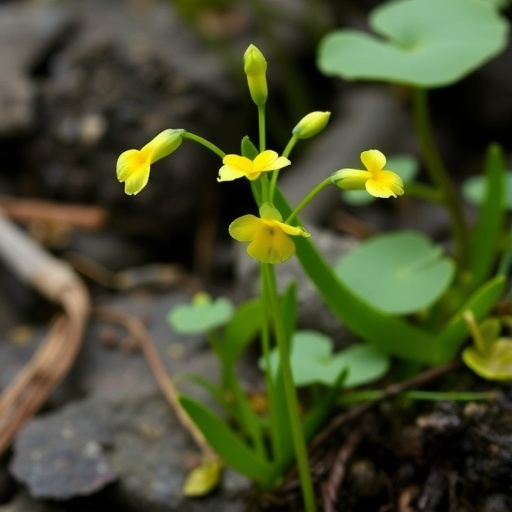In a groundbreaking study that has garnered significant attention in the botanical community, researchers have unveiled critical new information regarding the unique species known as Utricularia pierrei. This carnivorous plant, part of the diverse Utricularia genus, has been documented for its intriguing morphology and ecological adaptations, particularly in its native Lam Dong Province, Vietnam. This study not only enriches the existing literature but also raises fascinating questions about the evolutionary processes that shape such specialized flora.
Utricularia pierrei is characterized by its distinctive bladder-like traps, which serve as a sophisticated mechanism for capturing prey. These traps, which function like vacuum cleaners, are formed by modified leaves that actively ensnare small aquatic organisms. This adaptive feature enables the plant to supplement its nutrient intake in nutrient-poor environments. The research highlights how this carnivorous strategy is essential for survival and growth in the often challenging habitats of Lam Dong.
In dissecting the anatomy of Utricularia pierrei, researchers identified specific traits that differentiate it from other members of the Utricularia genus. The plant exhibits uniquely shaped bladders and intricate root structures that reflect its adaptations to its environment. By studying the morphological features, the authors were able to delineate this species from its closely related counterparts, which are often mistaken for one another. This level of detail is not only critical for taxonomy but also enriches our understanding of plant evolution.
Another significant aspect presented in the study is the ecological niche Utricularia pierrei occupies within its habitat. The plant thrives in shallow waters, often among floating vegetation, and plays a vital role in its ecosystem. As a carnivorous plant, it influences the populations of microorganisms in its vicinity, thus contributing to the neighborhood’s biodiversity. The presence of Utricularia pierrei indicates a balanced aquatic ecosystem where this species can flourish and fulfill its role as a predator.
In terms of conservation, the study underscores the importance of protecting Utricularia pierrei and its native habitats in Lam Dong Province. Rapid development and environmental changes pose significant threats to these unique ecosystems. The researchers emphasize the need for conservation efforts to preserve the delicate balance required for this species’ survival. Awareness and education about the ecological significance of such plants are essential for fostering support for conservation initiatives.
The findings also prompt further investigation into the potential applications of Utricularia pierrei in ecological restoration efforts. As a carnivorous plant, it could play a vital role in controlling pest populations in wetlands, potentially providing an environmentally friendly alternative to chemical pesticides. This aspect opens pathways for future research into harnessing the plant’s natural predatory attributes for agricultural benefits.
The research team’s methodological approach was meticulous, incorporating various techniques, including field surveys, morphological measurements, and molecular analysis, to provide a comprehensive understanding of Utricularia pierrei. By utilizing both qualitative and quantitative research methods, the study presents a well-rounded perspective on this species, setting a precedent for future botanical research endeavors. Their multi-faceted examination ensures a robust dataset that can be referenced by future studies on carnivorous plants.
Additionally, this research raises critical questions about the evolutionary origins of Utricularia pierrei and how its distinct features have developed in response to environmental pressures. The concept of evolutionary adaptation is central to understanding biodiversity and could provide insight into how climate change might affect similar plant species. Evaluating such dynamics aligns with broader biological discussions about resilience and survival in rapidly changing ecosystems.
One of the most intriguing insights from the study is the potential for Utricularia pierrei to exhibit variations depending on microhabitat conditions. Given its diverse environment, various morphological adaptations may exist within the species, influencing its growth patterns and reproductive strategies. This phenomenon encourages a closer examination of how local conditions shape plant characteristics and survival tactics, paving the way for future ecological and evolutionary studies.
Moreover, the authors discussed the implications of their findings for the broader field of botanical classification and taxonomy. By providing a clearer understanding of Utricularia pierrei, they contribute to ongoing debates about species delineation and the significance of morphological diversity. The research accentuates the importance of detailed taxonomic studies in ensuring that plant diversity is adequately represented and preserved within botanical literature.
As interest in exotic flora continues to grow among botanists and horticulturalists, Utricularia pierrei stands out as a captivating subject. Its carnivorous nature, combined with its unique habitat requirements, make it an ideal candidate for cultivation and study. Increased engagement with such species could foster a deeper appreciation for the complexities of plant life and the necessity of preserving biodiversity on our planet.
In conclusion, the research on Utricularia pierrei not only contributes valuable data to the field but serves as a call to action for conservationists, botanists, and the general public. Its unique attributes and ecological roles underline the necessity of protecting habitats that foster such extraordinary life forms. The implications of this research extend far beyond a single species, encapsulating the crises of biodiversity loss and environmental degradation that impact ecosystems worldwide.
As we continue to uncover the mysteries within our natural world, studies like this remind us of the delicate interconnections that exist within ecosystems and the vital roles that every species plays. The future of Utricularia pierrei, along with countless other plant species, hinges on our ability to recognize and act upon these crucial environmental challenges.
Subject of Research: Utricularia pierrei in Lam Dong Province, Vietnam
Article Title: New records on the botanical characteristics of Utricularia Pierrei distributed in Lam Dong province, Vietnam.
Article References:
Tran, M.H., Nguyen, L.A.K., Pham, V.N. et al. New records on the botanical characteristics of Utricularia Pierrei distributed in lam dong province, Vietnam.Discov. Plants 2, 220 (2025). https://doi.org/10.1007/s44372-025-00283-4
Image Credits: AI Generated
DOI:
Keywords: Utricularia pierrei, botanical characteristics, carnivorous plants, ecology, conservation, Vietnam
Tags: adaptations of aquatic plantsanatomy of Utricularia pierreibladder-like traps in plantsbotanical community studiesecological adaptations of Utriculariaevolutionary processes in carnivorous plantsLam Dong Province carnivorous plantsnutrient-poor environments floraspecialized flora of Vietnamunique morphology of UtriculariaUtricularia genus characteristicsUtricularia pierrei research





